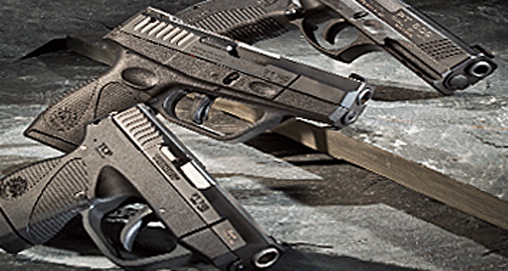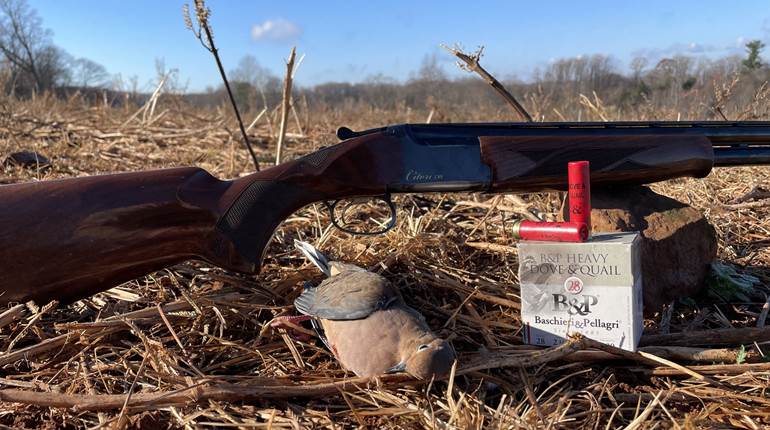
The threat of bodily harm, even death, at the hands of an assailant exists in our daily lives, no matter how much we may try to convince ourselves otherwise. For lackadaisical individuals, the lapse of concern is often attributed to the classic “other guy” syndrome-in other words: It’ll happen to someone else, not me. But if it did happen to you, would you be prepared to deal with it?
As threats come in many forms in various locations, a handgun optimally suited for one situation may prove only adequate in another. A merely “adequate” solution may seem sufficient, but when the lives of your family and yourself are on the line, an optimal solution is the only one worth considering.
The informed armed citizen should choose the best tool for the job. For example, although a “pocket pistol” is a good choice for concealed carry and close-range confrontations, is it the best option for home defense? Probably not. What about the full-size, high-capacity pistol? Certainly sheer firepower and enhanced accuracy give it an edge in certain situations, but for everyday carry is it practical? And what about the options found between these extremes? There’s a lot to consider.
Taurus offers options that address the varying needs for personal protection. Here are three options that will fulfill those needs for most people inside the home and out, and best of all, they also cover a range of price points; however, always consider practicality before price.
With the number of Right-To-Carry permits increasing exponentially in recent years, the demand for thin, lightweight, easily concealed handguns, and particularly those in .380 ACP, has grown with it. Taurus’ entry into this category is the PT 738 TCP (Taurus Compact Pistol).
The American-made PT 738 is a recoil-operated, locked-breech, hammer-fired semi-automatic designed from the outset for one purpose: covert carry. As such, the no-frills pistol is devoid of unnecessary accoutrements, and it is thoughtfully designed with regard to concealment qualities and user friendliness.
The polymer-frame PT 738 (738B) has aluminum guide rails and a stainless steel slide finished in black. The stainless slide on the 738SS retains its natural color, and on the 738Ti the slide is titanium. It features angles and lines that add to its overall appearance, aid in avoiding “printing,” and ease-and quicken-insertion into and removal from a holster. To further avoid “snagging” during the draw, the pistol’s rudimentary sights are integral, non-adjustable and low-profile; however, for close-quarters confrontations, the purpose for which the PT 738 TCP is intended, they’re adequate. Additionally, the only things projecting-and then only minimally-from the frame are the slide catch and disassembly latch, the latter of which is more like a pin. Even the magazine-release button, which is located to the rear of the trigger guard, blends in nicely.
As the Taurus PT 738 is double-action-only, requiring a lengthy, yet not overly heavy (5 to 7 pounds), and deliberate pull to discharge, the pistol has no manual safety-the result is one-less control to snag, as well as faster application of the handgun in a life-or-death situation. The company did, however, install its Taurus Security System (TSS) on the right, rear of the frame for additional security-note though, that the TSS should not be engaged when loaded. A loaded-chamber indicator, which is located directly above the extractor, provides a visual and tactile reference as to the gun’s condition-particularly helpful in low-light conditions. Also beneficial is that the TCP’s slide locks back after the last round is fired.
With regard to size, the PT 738 TCP lives up to its moniker, as it measures 0.87 inches (wide) by 3.75 inches (tall) by 5.2 inches (long), even with a 2.84-inch stainless steel barrel, and it weighs 10.2 ounces-9 ounces. for the PT 738Ti. Despite its minimalist dimensions, the pistol has a six-plus-one capacity of .380 ACP. Feeding the TCP is a single-stack, stamped metal magazine with a polymer bumper pad that serves to increase grip length. The additional length, combined with checkering on the frontstrap and backstrap and ribbing along the sides, makes the TCP controllable. Witness holes, along with a red/orange polymer follower, enable quick assessment of the number of rounds remaining in the magazine. Two magazines are included with the PT 738 TCP.
For the shooter demanding greater on-target energy, yet not wanting to forego concealment with ease, there’s the slightly larger PT 740 SLIM. The second offering in the SLIM line-the PT 709 is chambered in 9 mm Luger, and there’s the yet-to-be-introduced PT 708 in .380 ACP-the PT 740 is a recoil-operated, single-action/double-action, striker-fired semi-automatic pistol with six-plus-one capacity of .40 S&W.
Although chambered in the potent .40 S&W cartridge, the 19-oz. PT 740 lives up to its name, “SLIM”: it’s 1.04-inches wide, 5.35-inches tall and 6.24-inches in length-even with a 3.2-inch barrel. With the increased radius of its sights, which are in the familiar three-dot pattern and allow adjustability at the rear, the PT 740 is better-suited for self-defense at greater distances. The pistol’s single-action pull weight is between 5 and 7 pounds; however, in a self-defense scenario the trigger design enables it to be pulled again in a heavier double-action mode in a second attempt to fire the cartridge.
In addition to the manual safety, which is located behind the slide catch and is easily manipulated, there is a reciprocating trigger safety that impedes rearward movement of the trigger bar unless the trigger and trigger safety are pulled fully rearward together. The pistol also has a firing pin block that prevents the firing pin from moving forward unless the trigger is fully rearward and, like the TCP, the SLIM has the TSS; however, it’s on the rear, right side of the slide on the PT 740.
Like the PT 738, the PT 740’s blued carbon steel (740B) or stainless (740SS) slide and polymer frame-with steel guide rails-are contoured to enhance function, comfort and concealment. In fact, so close are the lines that, side-by-side, only a few differences are noticeable, and even then, they are mostly due to the larger frame of the PT 740. Notable exceptions are a reversible magazine-release button (for left-handed shooters) and an integral disassembly latch (as opposed to a removable pin). Additionally, the SLIM’s loaded-chamber indicator projects from the top-directly behind the ejection port-and not the side, as found on the TCP. It is also painted red for increased visibility.
The PT 740’s magazine is constructed from stamped metal, except for the plastic bumper pad, and holds six rounds. It also features five witness holes and a fluorescent orange polymer follower that clearly indicate the number of rounds remaining. Like the TCP, the SLIM’s slide locks back after the last round is fired.
PT 809
For the times when capacity and features trump concealment qualities and ease of portability, the PT 809, which was derived from the Taurus 24/7 OSS pistol-itself designed to meet U.S. Armed Forces requirements-is an excellent choice. The PT 809 is a single-action/double-action, recoil-operated, hammer-fired semi-automatic chambered in 9 mm Luger-similar models are also offered in .40 S&W (PT 840) and .45 ACP (PT 845)-with 17-plus-one capacity. Both carbon steel (809B) and stainless steel (809SS) versions are available.
Compared to the PT 740 SLIM, the PT 809 is considerable in size. It measures 1.14-inches wide, 6-inches tall and 7.75-inches long, and it weighs 30.2 ounces empty. Contributing to its length, and no doubt its accuracy, is a 4.2-inch stainless steel barrel, long sight radius and excellent low-profile, windage-adjustable Novak three-dot-pattern sights. The edges of the rear sight have been rounded to reduce snagging; however, the front didn’t receive such attention.
A significant departure from the TCP and the SLIM is that the PT 809’s controls-slide catch, disassembly latch, magazine-release latch (as it comes from the factory) and manual safety/hammer decocker-are ambidextrous. The latter enables the PT 809 to be carried either with the hammer cocked, thus employing the lighter single-action trigger pull, or when decocked, the first shot in the longer, heavier double-action mode.
The slide has both front and rear cocking serrations, as well as a black Tennifer finish for durability (809B). Like the PT 738 TCP and PT 740 SLIM, the PT 809 features a proportionally large extractor and lowered ejection port for reliability; however, the pistol’s loaded-chamber indicator is directly above the extractor, such as that found on the PT 738. In addition to the TSS, like the PT 740 the PT 809 has a firing pin block. After the last round is fired, the slide locks open.
Similar to its smaller cohorts, the PT 809’s polymer frame has metal guide rails and molded-in ribbing and checkering for purchase. Its disassembly latch is also identical to that found on the 740 SLIM; however, the similarities end there. The PT 809’s dust cover has an integral Mil-STD 1913 Picatinny accessory rail, and the backstrap can be replaced for a custom fit. Two extra inserts accompany the pistol. Additionally, the PT 809’s grip features molded-in finger grooves and a larger, more generous curve on the back of the grip-no doubt due to the pistol’s larger overall size.
Feeding the PT 809 is a double-stack, stamped metal magazine with 17-round-capacity. The PT 840 (.40 S&W) magazine holds 15 rounds, and the PT 845 (.45 ACP) holds 12. The magazine, which has witness holes and a fluorescent yellow follower for easier counting of rounds remaining, features a large bumper pad that further lengthens the gripping surface. It is unnecessary for all but the largest hands. Two magazines and a loading tool are included with the PT 809.
Testing Taurus’ Trio
To evaluate the PT 740, PT 738 and PT 809, each was subjected to a barrage of tests to determine not only accuracy potential, but also reliability and user-friendliness. The American Rifleman standard of five consecutive, five-shot groups at 25 yaeds for evaluating accuracy was followed for consistency, although such a distance is outside the intent of the PT 738 TCP’s design. That said, all of the pistols performed reasonably well with regard to accuracy.
Shooting the PT 740 SLIM was a welcome reprieve from normal .40 S&W-chambered pistols, as despite its thinness and abbreviated grip, it was relatively comfortable to shoot. Of course muzzle flip and recoil were load-dependent, with some producing higher levels than others. Particularly fun, yes fun, to shoot was Federal’s light-recoiling 135-grain Hydra-Shok JHP load, which was used to evaluate reliability with ammunition of different power levels.
During testing, the PT 740 exhibited three failures to feed, but all were restricted to a single ammunition brand and occurred early in the evaluation phase. No other malfunctions took place, illustrating that it needed a brief “break-in” period before being pressed into service-not a bad idea for any handgun used for self-defense. When the magazine-release button was depressed, the magazine was quickly expelled, thereby enabling rapid changes.
The most accurate load, Hornady’s 155-grain HP XTP TAP FPD, averaged 3.5 inches; however, had it not been for the extra-long and -heavy trigger pull, groups likely would have been a bit smaller. Additionally, it must be noted that as the gun came from the factory it was hitting 2 to 3-inches low at 7 yards-self-defense distance-and proportionately more as range increased. Fortunately, the PT 740 features adjustable sights.
After evaluating the PT 740, shooting the PT 738 seemed, well…insignificant; however, appreciating the .380 ACP, as well as carrying one frequently, I respect the trade-off of power for portability. The pistol was not unpleasant to shoot, despite my pinky swinging freely beneath the magazine; however, long sessions would likely be wearing. I found the 738’s trigger better than the 740’s; however, its bare-bones sights negate much of that benefit. Add to that the .380 ACP’s minimal ft.-lbs. of energy and rainbow-like trajectory, and one can easily see why the pistol is not a long-range fight-stopper. All things considered, though, the pistol performed better than expected, with the best load-Winchester’s Supreme Elite 95-gr. Bonded PDX1-averaging 4.28 inches. The PT 738 was also impacting approximately 2 to 3-inches low at 7 yards, and significantly lower as distance increased. Because the sights are integral, adjustments cannot be made without altering them.
The PT 738 exhibited no mechanical problems until the end of the testing phase, at which time it began to have feeding issues. The problem was easily diagnosed: the magazine catch was failing to keep the magazine in place, and as the magazine slid downward reliable feeding was hampered. As such, the pistol was returned to Taurus. In the meanwhile, a second PT 738 was exhaustively tested with a range of ammunition to ensure this wasn’t a design fault, and with the exception of a single failure to feed in the first magazine, no other problems were encountered.
The final pistol tested, the PT 809, turned out to be my favorite; however, its size would discourage my carrying it daily. For home defense or recreational shooting, though, it would excel. During the evaluation, the handgun experienced a single failure to feed, which, like the PT 740, occurred early on. No other malfunctions were encountered.
Because the PT 809 wore Novak’s excellent low-profile sights, I expected it to exhibit accuracy superior to its brethren, and the pistol delivered. The most accurate load proved to be Hornady’s 115-grain Critical Defense, which averaged 2.92 inches. All loads impacted close to the bullseye at 7 yards, and obviously as distance increased so did bullet drop; however, it’s worthy of note that the pistol’s sights are non-adjustable for elevation.
More enlightening to me, though, was what occurred not during accuracy testing, but in the reliability evaluation. Having previously handloaded some practice-only ammunition-note the use of reloads voids all warranties-100 of them accompanied me to the range. Loaded with new propellant and old, yet properly stored, primers, the full-metal-jacket ammunition was suitable only for informal range work. Interestingly, four of the rounds failed to fire the first time-no doubt because of the aged primers, since all of the primers were properly seated-however, a quick, almost-instinctive, subsequent trigger pull fired three.
Just to ensure a light primer strike wasn’t to blame, after waiting 10 seconds-and avoiding direct exposure to the ejection port-the fourth round was removed and inspected. Indeed, the firing pin hit with full force; therefore, one could reason it was a defective primer. After rechambering the round, a subsequent trigger pull fired it.
This begs the question, “What’s the likelihood of new-manufacture ammunition failing to fire the first time?” Probably minimal; however, if you can have a second chance at making the cartridge fire, then why not? According to Taurus, “Research indicates a 93 percent or better chance the round will fire on a re-strike.” For me, all four cartridges that failed to fire on the initial pull indeed fired when the trigger was pulled a second time.
Know, however, that there are those who adamantly oppose this protocol, preferring “tap, rack, bang.” To this end I must say, to each his own-you can obviously do either with the single-action/double-action, hammer-fired semi-automatic PT 809, but for the PT 740, a striker-fired semi-automatic, it’s a seldom-encountered addition that gives the end user choices. The PT 738 offers no such choice.
Self-defense pistols are specialized firearms. The key has been, and remains, finding the one most closely designed for the circumstances in which it’s likely to be employed. Fortunately, Taurus recognizes this and offers conscientious concealed-carry consumers with a host of options. Among those the PT 738 TCP, PT 740 SLIM and PT 809 are likely to fit the needs of most any shooter.





































